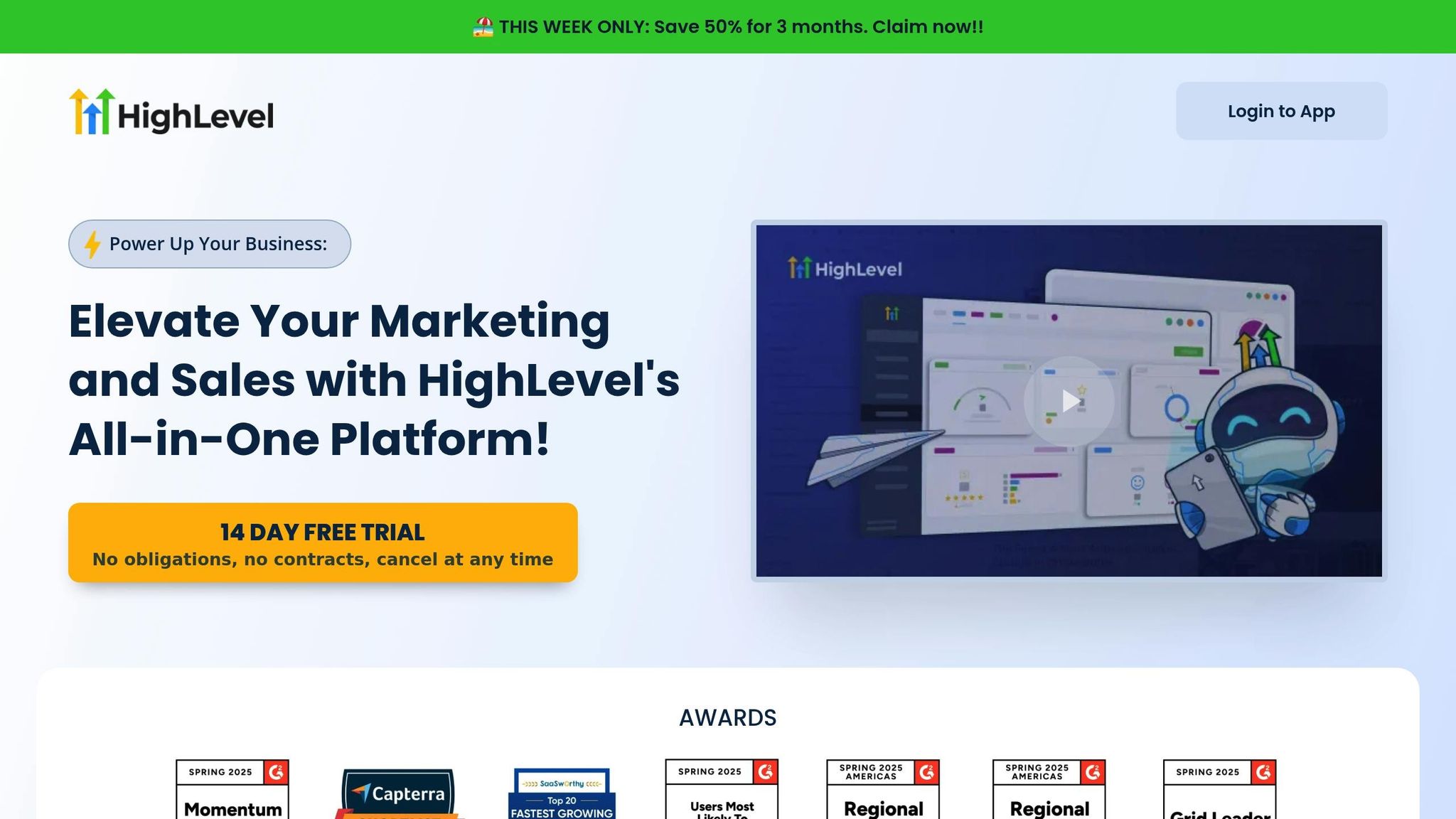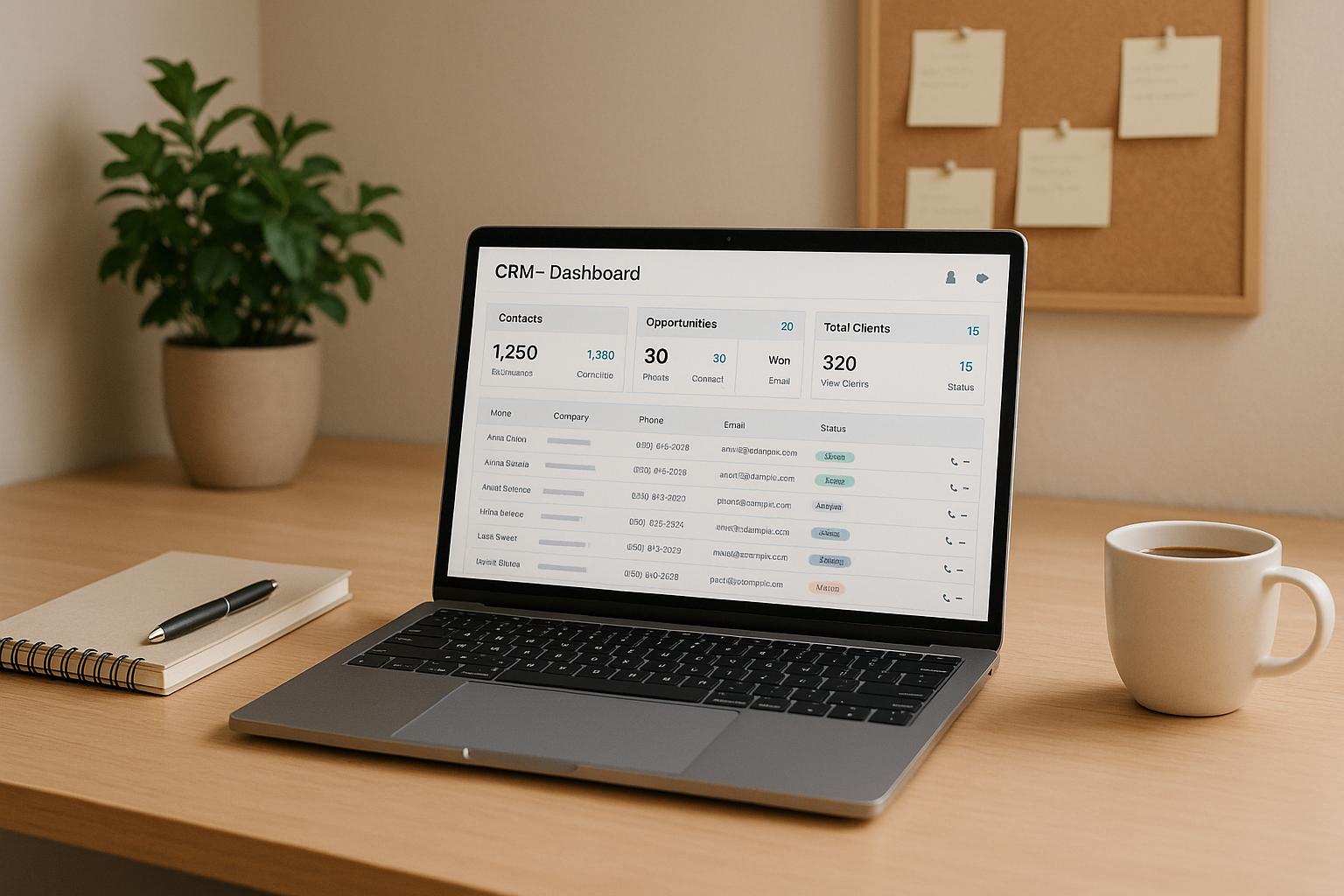Webhooks are essential for automating workflows in HighLevel, but errors can disrupt operations. Common issues include connection failures, server response errors, duplicate or missed events, rate limiting, and data mapping problems. These errors can lead to incomplete data transfers, missed events, and workflow disruptions.
Key Takeaways:
- Connection Failures: Caused by timeouts, unreachable endpoints, or server issues.
- Server Response Errors: Result from unexpected HTTP codes or incorrect data formats.
- Duplicate/Missed Events: Triggered by timing glitches or improper API logic.
- Rate Limiting: Happens when request volumes exceed limits, causing delays.
- Data Mapping Issues: Occur when payloads are missing fields or have mismatched data types.
How to Fix:
- Check the 'Needs Review' Tab: Identify errors in workflows.
- Review Execution Logs: Analyze error details like response codes and payloads.
- Test Payloads: Validate webhook functionality with tools like Webhook.site.
-
Address Specific Errors:
- Fix connection and timeout issues by verifying URLs and server performance.
- Resolve response errors by ensuring headers, payloads, and authentication are correct.
- Prevent duplicates by using idempotency and automated retries.
- Handle rate limiting with throttling and load balancing.
- Correct data mapping by aligning field names and formats.
Prevention Tips:
- Test webhooks thoroughly before going live.
- Monitor success rates and set up alerts for errors.
- Document all webhook configurations and update regularly.
- Plan for traffic spikes with scalable infrastructure.
By proactively managing and fixing webhook errors, you can maintain smooth workflows and avoid disruptions in HighLevel.
How to Use Webhooks in HighLevel

5 Common Webhook Errors in HighLevel
Understanding common webhook errors is key to keeping your HighLevel automations running smoothly. Let’s break down the five most frequent issues that can disrupt workflows and how they occur.
Connection Failures
Connection failures happen when a webhook can’t reach its destination. This might be due to timeouts, unreachable endpoints, DNS issues, or expired credentials. Other culprits include server downtime, routine maintenance, or traffic spikes that result in 503 errors during peak demand.
When troubleshooting, it’s also important to look at server response issues that arise when webhooks do reach their destination but encounter unexpected responses.
Server Response Errors
Server response errors occur when the endpoint returns unexpected HTTP codes like 400 (Bad Request), 401 (Unauthorized), 500 (Internal Server Error), or 502 (Bad Gateway). Another common issue is receiving data in an incorrect format - such as HTML when JSON is expected.
These errors often stem from error pages being sent instead of proper API responses. Next, let’s address a problem that can mess with your data integrity: duplicate or missed events.
Duplicate or Missed Events
Duplicate or missed events lead to inconsistencies in your data and can throw your workflows off track. Timing glitches or buggy API logic might cause events to fire multiple times or not at all, resulting in repeated or incomplete updates.
"If you don't need to return any data, the recommended suggestion for these issues is actually to return a 200 response immediately after the webhook trigger module, THEN continue the rest of the scenario." - samliew, Solution Maestro 🌟
Issues with trigger settings or API behavior are often behind these problems. Now, let’s look at rate limiting and server overload.
Rate Limiting and Server Overload
Rate limiting kicks in when request volumes exceed specified limits, triggering 429 errors. Server overload, often signaled by CPU usage exceeding 80%, can degrade performance and cause cascading failures during high traffic periods.
While webhooks can reduce API call volumes by 30%, this efficiency can backfire if your server isn’t equipped to handle the burst of concentrated requests. Interestingly, 72% of software development companies reported improved efficiency after adopting webhooks, though many initially faced challenges with rate limiting.
Lastly, let’s examine data mapping and payload issues that can disrupt webhook processing.
Data Mapping and Payload Problems
Data mapping errors arise when payloads are missing required fields, use incorrect data types, or contain malformed JSON. These issues are compounded when field names between the sender and receiver don’t match.
For example, if the webhook sends a field labeled "customer_email" but your system expects "email_address", the data won’t map correctly, leading to incomplete processing and workflow errors. Consistency in field naming is crucial to avoid these disruptions.
How to Find Webhook Errors in HighLevel
HighLevel provides built-in tools to help you locate and resolve webhook errors. With the right steps, identifying and addressing issues becomes much easier.
Check the 'Needs Review' Tab
The 'Needs Review' tab is your go-to resource for spotting workflows with errors. To access it, head to your workflows list page and click on the tab. This will show you all workflows that have encountered issues and take you directly to the execution logs for each one.
You can also mark errors as read to keep track of which issues you've already reviewed, making troubleshooting more organized and efficient.
By default, HighLevel disables notifications for workflow errors, so you'll need to enable them manually in the Workflow Settings. Once activated, you'll receive an email immediately when an error occurs. If additional errors are detected after 24 hours, you'll get another notification.
After identifying errors in the 'Needs Review' tab, dive deeper by examining the detailed execution logs.
Read Workflow Execution Logs
Execution logs give you a detailed breakdown of how contacts move through your workflows and every action they encounter. These logs are essential for spotting errors that might disrupt your webhook operations.
Errors are easy to identify thanks to visual cues like highlights in the Status field or the 'View Details' link. These indicators help you quickly locate the problem areas in your logs.
The Action column now displays the custom 'Action Name' you assign to each step, and hovering over it reveals the actual action type for added context. When you see a highlighted error, click 'View Details' to access specifics like error messages, response codes, and payload information. This data is crucial for diagnosing why a webhook failed.
The logs also include timezone data in the 'Executed On' field, showing when each action occurred. This timing information can help you identify patterns in errors or align them with external system maintenance schedules.
Once you've pinpointed the issue, validate your findings by testing with sample payloads to avoid future disruptions.
Test with Sample Payloads
Testing sample payloads is a proactive way to ensure your webhook endpoint is functioning correctly before using it in live workflows. This step helps you identify configuration errors, data mapping problems, and connectivity issues early on.
Testing also verifies that your external application can receive webhook data properly and confirms that the data is sent as a JSON object, which is the required format in HighLevel.
Julian Mills suggests a simple trick for triggering a webhook with basic data when you're unable to do so from a third-party tool. Add
?first_name=testfirstname&last_name=testlastnameto the end of your webhook URL and paste it into a browser. This allows you to save the webhook trigger in HighLevel and complete the workflow setup before going live.
For more complex troubleshooting, you can use Webhook.site. Replace your HighLevel API URL with Webhook.site's testing URL to see the exact payload being sent. This tool helps you identify formatting or content issues in your data.
When testing outbound webhooks, simulate the workflow as if it were live. This ensures all example data is included in the payload, allowing you to catch edge cases and inconsistencies before they cause problems in production.
sbb-itb-f031672
How to Fix Common Webhook Errors
Once you've identified errors using HighLevel's tools, the next step is to tackle them head-on to keep your workflows running smoothly. Addressing these issues promptly ensures HighLevel operates seamlessly, which is critical for effective lead generation.
Fix Connection and Timeout Errors
Start by double-checking your HighLevel webhook URL - one small typo can lead to failure. Then, assess your server's performance, including CPU, memory, and storage, to make sure it can handle incoming requests efficiently. Your server should immediately return a 2xx status code upon receiving a webhook request. If your application has tasks that take longer to process, acknowledge the webhook right away and handle the heavier workload asynchronously.
Timeout errors like ETIMEDOUT, ESOCKETTIMEDOUT, and ECONNRESET often signal server overload or incorrect timeout settings. Tools such as Beeceptor or RequestBin can help you test and verify your endpoint's functionality.
Fix HTTP Response Errors
Once connection issues are resolved, focus on how your server processes requests to fix response errors. For HTTP errors like 400, 401, 403, 404, 500, 503, or 504, check the following:
- Ensure headers are properly configured.
- Validate JSON payloads for accuracy.
- Confirm authentication tokens are correct.
- Dive into server logs to uncover potential misconfigurations.
Stop Duplicate or Missed Events
To prevent duplicates or missed events, implement idempotency, use atomic database operations, and set up a queueing system with automated retries.
"Webhooks may be sent more than once. You'll need to respond with a 2xx HTTP status code to Square as soon as possible to acknowledge the receipt of the event notification. If your application fails to acknowledge in a timely manner, a duplicated event will be sent that your application has 10 seconds to respond to."
– Bryan-Square, Square Employee
Additionally, monitor your webhook's performance using detailed logging and set up alerts to detect unusual behavior before it disrupts your workflows.
Handle Rate Limiting and Overload
To manage high traffic and avoid rate-limiting errors, implement throttling, asynchronous processing, and load balancing. These steps help your system handle spikes in traffic without interruptions.
Fix Data Mapping and Payload Problems
Make sure your JSON payload aligns with system requirements, includes all necessary fields, and uses consistent field names. Test a variety of scenarios to identify formatting or data type issues. HighLevel's custom field mapping feature can help you align data fields between systems. Also, keep your documentation up to date to reflect any changes in your custom fields or the data requirements of the receiving system.
How to Prevent Webhook Errors
Avoiding webhook errors is much easier when you take proactive steps to ensure everything runs smoothly. By testing thoroughly, keeping an eye on performance, and preparing for high traffic, you can sidestep most issues and keep your HighLevel integrations operating efficiently. Here's how you can do it.
Test Webhooks Before Going Live
Before deploying webhooks in a live environment, it's essential to test them rigorously. Start with unit testing to catch logic errors in specific functions, and follow up with functional testing to confirm that the entire webhook workflow operates as expected from start to finish.
Don't skip load testing - this will help you understand how your application performs under heavy network traffic. Tools like Postman can simulate real-world scenarios, letting you test success, failure, and invalid data responses. Use profiling to pinpoint performance bottlenecks and optimize them before they become an issue in production.
If you're unable to directly trigger the webhook, you can add basic data to the webhook URL and test it later with real data. Writing tests for every possible use case ensures your webhook can handle anything thrown its way, confirming its functionality in real-world conditions.
Monitor Webhook Performance
Ongoing monitoring is key to catching issues early. Keep an eye on webhook success rates, track recurring problems, and look out for suspicious activities that might signal security or system issues. HighLevel's analytics tools can help you identify patterns and troubleshoot faster.
Set up logging and monitoring systems to quickly detect and resolve errors. Consider implementing a self-healing process to address certain issues automatically, reducing the need for manual fixes. Monitoring also helps you plan for future needs by analyzing usage trends and capacity requirements.
Document Your Webhook Setup
A well-documented webhook setup can save you a lot of headaches. Keep detailed records of all your endpoints, expected data, error-handling processes, and any custom field mappings. Update this documentation whenever you make changes to your configuration.
Include details about query parameters in your webhook URLs for easier data mapping, and make note of any third-party tools or configurations in use. Comprehensive documentation ensures your system is prepared for any situation, even during high-traffic periods.
Plan for High Traffic
Traffic spikes can lead to errors if your system isn't ready. To handle peak loads, implement strategies like throttling incoming requests, using asynchronous processing for time-intensive tasks, and applying load balancing to distribute traffic across multiple servers.
Configure your server to immediately return a 2xx status code for incoming webhook requests. This confirms receipt while heavier processing happens asynchronously, helping to avoid timeout errors. Tools like Beeceptor or RequestBin can verify how your endpoint behaves under different load conditions.
Prepare for seasonal traffic surges by testing your capacity regularly. Scale your infrastructure before hitting its limits, and use queueing systems with automated retries to manage overloads effectively. Checking your webhook proxy URL (e.g., smee.io) ensures notifications are sent and received as expected.
Conclusion: Keep Your HighLevel Webhooks Working
Tackling common webhook errors is essential to keeping your workflows running smoothly. By addressing issues like connection failures, server response errors, duplicate events, rate limiting, and data mapping challenges, you can spot and resolve problems before they disrupt your operations. Regular monitoring and routine checks are crucial for staying ahead of potential issues.
Make it a habit to review your API call logs consistently - HighLevel stores these logs for 60 days. This gives you plenty of time to identify trends and catch problems early. Additionally, revisiting your configurations every quarter and updating documentation after any API or workflow changes can simplify troubleshooting down the line.
Agencies that prioritize regular payload testing and log reviews often see tangible benefits: fewer missed or duplicate events, improved lead tracking accuracy, and faster client response times. These practices not only enhance operational efficiency but can also lead to better client ROI by minimizing downtime and optimizing marketing efforts.
If issues persist despite your best efforts, escalate them with detailed logs and payload data to ensure swift resolution.
Your HighLevel webhooks are the backbone of your automated processes. Keeping them reliable through consistent monitoring, thorough testing, and up-to-date documentation is key to maintaining smooth and uninterrupted operations.
FAQs
How can I effectively test webhooks in HighLevel to avoid errors before going live?
To make sure your webhooks operate smoothly in HighLevel, start by testing the webhook URL and payload with sample requests. This step ensures the data is formatted correctly and being received as intended. Experiment with different HTTP request methods, such as POST or GET, to confirm everything aligns properly.
During testing, keep things simple by using basic data. This approach makes it easier to identify any issues and verify that the setup is working as it should. Tools like 'Fetch Sample Requests' can also help validate the webhook’s response, minimizing the chances of errors when you go live. A thorough testing process ensures your workflow automation runs without a hitch.
How do I monitor and resolve webhook issues in HighLevel workflows?
To keep your webhooks running smoothly in HighLevel, start by testing their delivery using tools designed to simulate and verify responses. Double-check that your webhook URLs are correctly set up, active, and ready to handle incoming requests. It's also a good idea to regularly check the webhook status in HighLevel's workflow settings to spot and fix any errors early.
For continuous monitoring, use tools that send real-time alerts for failures and provide performance insights. These can help you quickly pinpoint and resolve issues, ensuring your integrations stay reliable and your workflows run without interruptions.
How can I manage high webhook traffic and prevent rate limiting errors in HighLevel?
To handle high webhook traffic in HighLevel and avoid running into rate limiting errors, you can apply a few smart strategies:
- Implement a retry system with exponential backoff: This ensures failed requests are retried gradually, preventing your system from being overloaded.
- Regularly monitor webhook performance: Keeping an eye on performance helps you spot bottlenecks early and make adjustments to improve efficiency.
- Use throttling and batching: These techniques spread out traffic more evenly, reducing the chances of triggering rate limits.
On top of that, make sure your webhook retries are set up to manage issues like network errors, timeouts, and non-2xx responses. By following these steps, you can keep data flowing smoothly and maintain reliable workflows, even during peak traffic times.



